Mounting multiple LCD monitors on the wall can transform your workspace. It saves space and offers a cleaner, more efficient setup. In this article, I will guide you step by step on how to mount multiple LCD monitors on the wall. Save space, and achieve a cleaner setup.
Table of Contents
ToggleStep 1: Choose the Right Wall Mount
Selecting the Ideal Wall Mount for Multiple LCD Monitors
When learning how to mount multiple LCD monitors on the wall, selecting the right wall mount is crucial. The wall mount serves as the foundation of your setup. It determines the stability and positioning of your monitors. Without a suitable mount, your monitors might be at risk. Thus, investing time in choosing the right one is essential. This choice ensures the safety of your monitors and the overall aesthetics of your workspace.
Understanding Different Types of Wall Mounts
First, you need to know the different types of mounts. There are three main types: fixed, tilt, and full-motion mounts. Fixed mounts keep your monitors in a stable position. They are ideal for setups where you do not need to adjust the angle. A fixed mount is straightforward to install. It provides a simple and sleek look. However, it lacks flexibility. If you prefer a dynamic setup, this may not be the best option.
Exploring the Flexibility of Tilt Mounts
Tilt mounts offer more flexibility than fixed ones. They allow you to adjust the angle of the monitors slightly. This adjustment is useful if you want to reduce glare from windows or lights. It also helps to find a comfortable viewing angle. Tilt mounts are a middle ground. They provide some flexibility while maintaining a clean look. However, they do not offer as much range as full-motion mounts.
Maximizing Versatility with Full-Motion Mounts
Full-motion mounts, on the other hand, provide the most versatility. These mounts can swivel, tilt, and extend away from the wall. They allow you to adjust the position of your monitors freely. Full-motion mounts are perfect if you have a dynamic workspace. You can move the monitors as needed throughout the day. This feature is especially useful if you often work on different tasks. However, full-motion mounts can be more expensive. They also require a more complex installation process.
Considering Weight Capacity for Safety
When choosing a wall mount, weight capacity is critical. Every mount has a weight limit. Exceeding this limit can lead to serious risks. The mount may become unstable or even break. To avoid this, always check the combined weight of your monitors. Compare it to the weight capacity of the mount. Select a mount that can safely hold your monitors. It’s better to choose one with a little extra capacity, as this ensures a safe and stable setup.
Ensuring VESA Compatibility for Proper Fit
Another important consideration is the mount’s VESA compatibility. VESA standards ensure that the mounting holes on your monitors match the wall mount. Most modern monitors follow the VESA standard. Check the VESA pattern on your monitors and match this with the mount’s VESA compatibility. This step will save you time and prevent frustration during installation. You may need an adapter if your monitor does not follow VESA standards.
Evaluating Material Quality for Durability
You should also consider the material and build quality of the mount. A sturdy mount provides long-term reliability. Look for mounts made of high-quality materials, like steel or heavy-duty aluminum. These materials offer better durability. They also ensure that the mount can withstand daily use. Avoid cheaper mounts made of flimsy materials. These might fail over time, putting your monitors at risk.
Choosing Aesthetically Pleasing Mounts
Next, think about the aesthetics of the mount. A clean and sleek mount can enhance the look of your workspace. It should blend well with your existing setup. For instance, a black or silver mount often matches most monitors and desks. Consider the appearance of the mount, especially if your setup is visible to clients or guests. A well-chosen mount not only serves a functional purpose but also improves the overall look of your space.
Planning Monitor Positioning for Optimal Viewing
Transitioning from a desk setup to wall-mounted monitors also means planning the positioning. Think about where you want the monitors on the wall. A well-placed mount can make a huge difference in your viewing experience. It can also improve your productivity. Positioning the monitors at eye level is ideal. This helps prevent neck strain during long work hours. Before purchasing a mount, visualize your setup. Measure the height and distance from your desk to the wall. This ensures that the mount you choose fits your needs perfectly.
Evaluating Scalability for Future Expansion
Furthermore, consider how many monitors you want to mount. Some mounts are designed specifically for single monitors. Others can support two or even three monitors. If you plan to expand your setup in the future, opt for a mount with this flexibility. It allows you to add more monitors without changing the entire setup. This saves you time and effort later on.
Checking Customer Reviews for Reliability Insights
Finally, don’t forget to check customer reviews. Reviews provide insights into the durability and performance of different mounts. Look for feedback on the installation process, build quality, and overall experience. Customers often share useful tips and warnings. This information can help you avoid potential pitfalls. Choosing a well-reviewed mount gives you confidence in your purchase.
By considering all these factors, you can select the perfect wall mount for your monitors. The right mount will ensure stability, flexibility, and a professional appearance. It also helps you make the most of your workspace. With the right wall mount, you are one step closer to a streamlined and efficient monitor setup.
Step 2: Gather the Necessary Tools
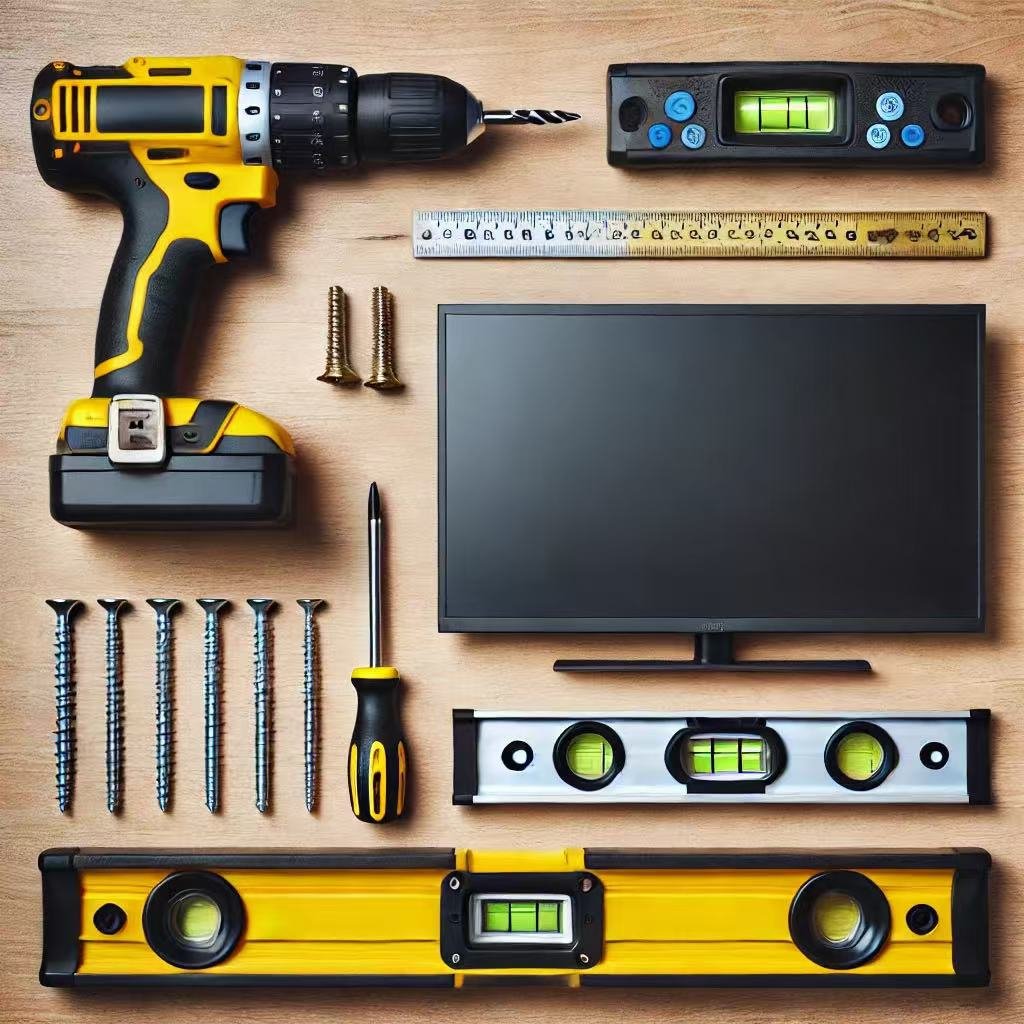

Before mounting multiple LCD monitors on the wall, gathering the right tools is essential. This step ensures a smooth installation process. Having all the tools ready saves time and avoids interruptions. You can focus on each step without pausing to find missing equipment. Here’s a detailed look at the tools you’ll need and how to use them.
Must-Have Tools for Mounting LCD Monitors
First, you will need a drill. A drill helps create holes in the wall for screws. Choose a drill with multiple speed settings for better control. It allows you to work with different wall materials, such as drywall or concrete. A powerful drill ensures you can secure the wall mount properly. Without a drill, creating stable holes for the mount is nearly impossible.
Next, get screws that match your mounting bracket. Most wall mounts come with a set of screws. However, always check if they fit the type of wall you have. For example, drywall requires specific screws for a secure hold. If you are unsure, ask at a hardware store. They can recommend the right screws for your wall type. Using the correct screws prevents accidents, like the mount becoming loose over time.
Additional Tools for Accuracy
You will also need a level. A level ensures your mounted monitors remain straight. It helps you avoid a tilted setup. Hold the level against the bracket before securing it with screws. Adjust until the bubble is centered. This step is crucial for aligning multiple monitors. An unaligned mount can affect your viewing comfort. A level is a small tool, but it makes a big difference.
Moreover, include a screwdriver in your toolset. Use it to tighten screws, ensuring the bracket stays firm on the wall. An electric screwdriver can make this job faster. But a manual screwdriver works well too. It gives you control over the tightness of each screw. Loose screws can compromise the stability of your mount. Tighten each one securely to avoid future issues.
Safety Equipment to Consider
Safety is also a priority when mounting LCD monitors. Wear safety goggles to protect your eyes from dust and debris. Drilling into walls can release small particles. These can irritate your eyes if not protected. Safety goggles are an inexpensive way to prevent potential injuries.
A stud finder is another useful tool. It helps you locate studs in the wall. Studs are solid points that provide better support for heavy items. Mounting directly into a stud ensures your monitors stay secure. Without a stud finder, you risk attaching the mount to weaker parts of the wall. This can lead to a dangerous, unstable setup. A stud finder simplifies this part of the job.
Why Preparation Matters
Gathering the right tools beforehand makes the process smoother. It prevents delays and helps you work efficiently. You won’t need to stop midway to buy a missing tool. Instead, you can focus entirely on the installation. Proper preparation also ensures better results. With the right tools, your mount will be more secure. Your monitors will align properly, giving you a neat and professional setup.
Additionally, investing in quality tools pays off in the long run. Cheap or improper tools can damage your walls or monitors. For example, using the wrong type of drill bit might cause the wall to crack. High-quality tools, even if slightly more expensive, ensure a smoother installation. They reduce the chances of mistakes and save time in the long term.
Organize Your Tools Before Starting
Before starting, lay out your tools in a convenient location. A small tool tray or box can keep everything in one place. This organization prevents frustration during the installation. You won’t waste time searching for a lost screw or level. Keeping tools within reach ensures you maintain focus. It also speeds up the process. This is especially important if you are working alone. A well-organized toolset makes the entire task easier.
Review Your Tool List
Finally, double-check your tool list before beginning. Make sure you have the drill, screws, level, screwdriver, safety goggles, and stud finder. If any tool is missing, purchase it before starting. A complete toolset sets you up for success. It helps avoid mistakes and ensures a sturdy, long-lasting installation.
By taking the time to gather all the necessary tools, you can focus on the actual mounting process. This preparation ensures your LCD monitors are secure and aligned. With these tools, you’ll achieve a professional and efficient setup.
Step 3: Find the Right Spot on the Wall
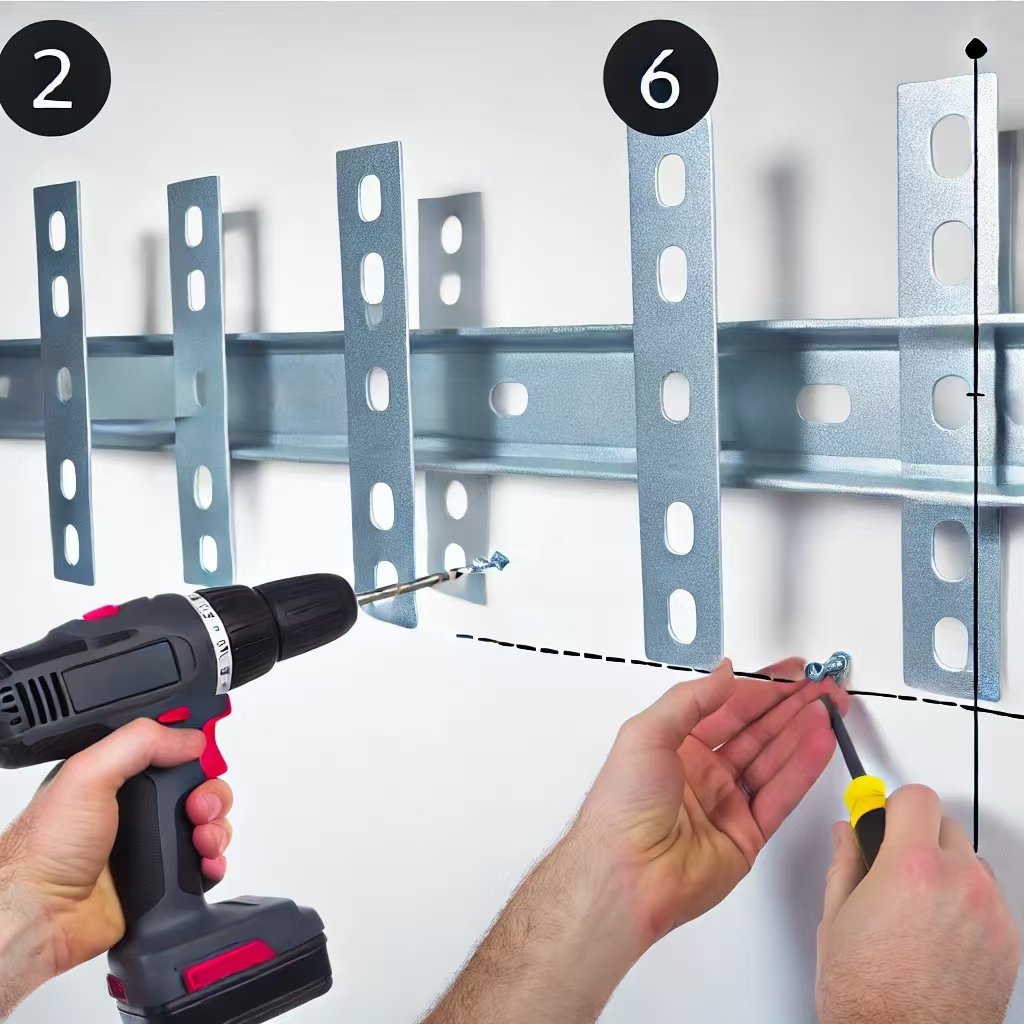
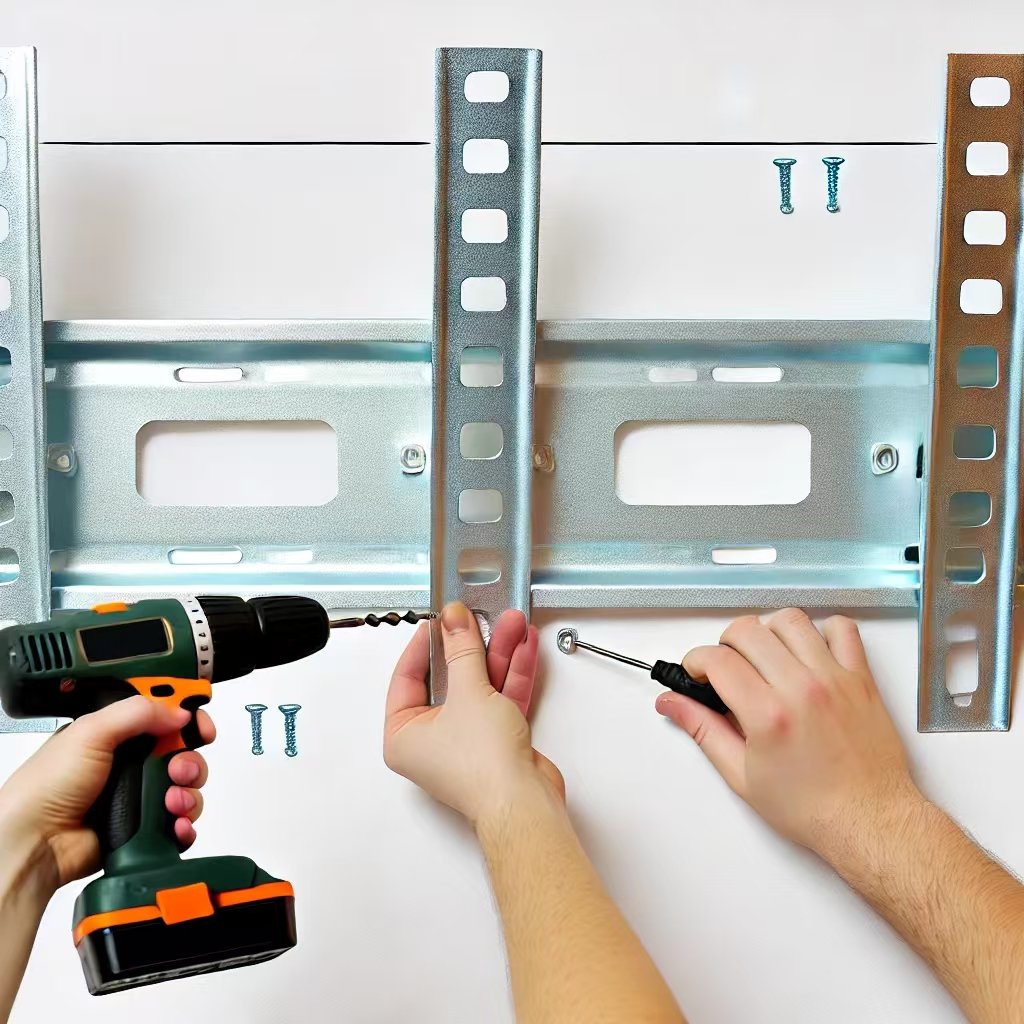
Finding the right spot to mount your monitors is crucial. It affects both the stability of the installation and your viewing comfort. You want a location that supports the weight of the monitors and offers a good line of sight. Start by choosing a wall that is both sturdy and close to power outlets. This will make it easier to manage cables and connect your monitors without extra hassle.
Check the Wall’s Structure
First, check the wall’s structure. You need to ensure the wall can hold the weight of multiple monitors. Drywall alone might not be strong enough. Instead, look for walls with studs. A stud finder can help locate these wooden beams behind the wall. These beams provide a solid foundation for mounting. Using studs helps prevent the mount from pulling away over time.
Studs typically run vertically inside the walls. Mark the location of each stud with a pencil. Make sure the marks are visible enough for the next steps. This simple action ensures you drill in the right places. Drilling directly into studs provides better stability for your mount. It also helps to avoid damaging the wall.
Decide on the Viewing Height
Next, determine the ideal height for mounting the monitors. The center of the screen should be at eye level. This prevents strain on your neck and eyes during long hours of use. Sit or stand in your typical working position. Then, mark where your eyes naturally fall. This mark is a good starting point for positioning the monitors.
If you use multiple monitors, consider how you want them arranged. Horizontal setups work well for tasks that require a wide view. Vertical stacks are ideal for those who need to view multiple documents or data streams. Either way, keep the viewing height comfortable. Adjust your marks as needed until you feel satisfied with the layout.
Measure the Space Between Monitors
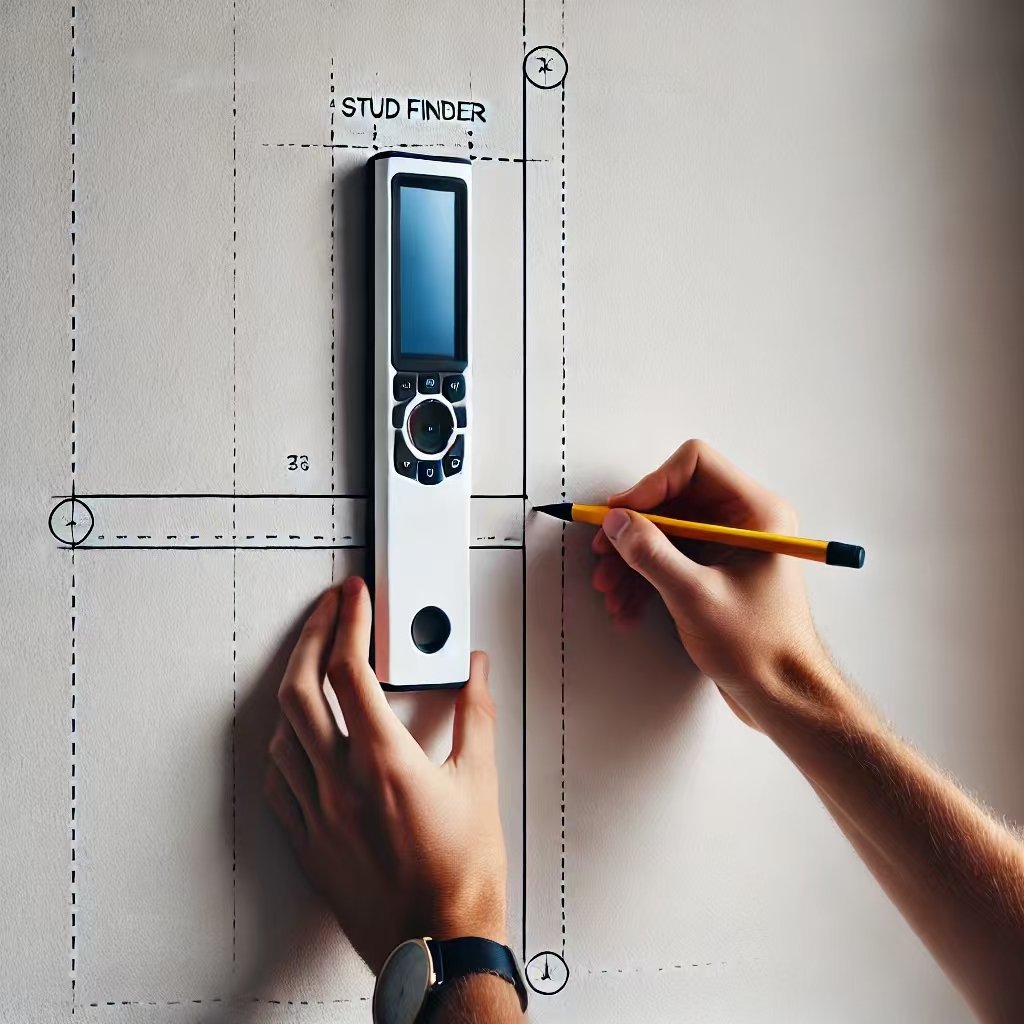
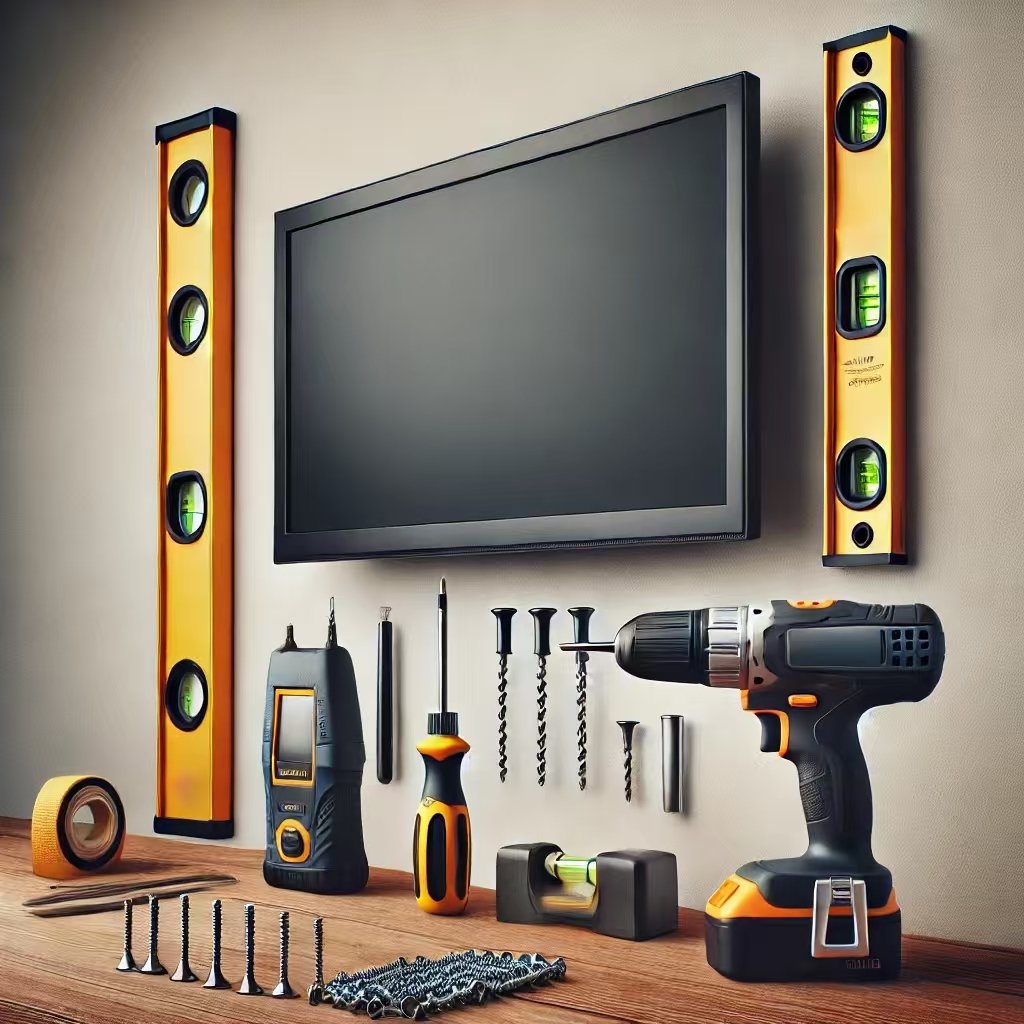
After determining the height, measure the space between each monitor. Proper spacing ensures a balanced look. It also helps with airflow between the screens, preventing overheating. Use a tape measure for accurate measurements. Mark these spaces with a pencil to keep your layout consistent.
For a seamless setup, try to align the tops or bottoms of all the screens. This creates a more polished appearance. Measure twice to ensure accuracy. A few extra minutes of planning can save you time and frustration later. Consistent spacing also makes adjusting the monitors easier once they’re mounted.
Check for Nearby Obstacles
Before you drill, consider any obstacles around the mounting area. Look for nearby furniture, windows, or doors. You don’t want the monitors to block access or create glare from natural light. Adjust your marks if you notice potential issues. This step prevents the need to redo your work later.
Additionally, make sure you have enough space to access cables behind the monitors. If the wall is too close to a desk or cabinet, it could make connecting cables difficult. A bit of extra space allows you to reach behind the monitors for adjustments. This saves you from having to remove the monitors every time you need to change a cable.
Test the Viewing Angle
Testing the viewing angle is also important. Stand back and look at your marked positions. Try to visualize how the monitors will appear once mounted. If you have adjustable mounts, remember that you can tweak the angle later. But it’s still a good idea to start with an ideal base position.
Ask yourself if the angle feels natural. You want a setup that allows you to see the screens without straining your eyes or neck. A slight tilt can sometimes make a big difference. Adjust the marks if necessary to ensure a comfortable viewing angle. This step helps to reduce eye strain, especially when using the monitors for long periods.
Think About Cable Management
When choosing the mounting spot, plan for cable management. Properly routed cables keep your setup neat. They also help prevent damage from accidental tugs. Ideally, you want to position your monitors close to power outlets. This minimizes the need for long cables. Shorter cables tend to stay organized better.
Use cable clips or channels to route cables along the wall. This gives your setup a cleaner look. It also keeps the cables from becoming tangled. By thinking about cable management now, you avoid the frustration of a messy setup later. A well-organized space is more appealing and easier to maintain.
Consider Future Adjustments
Lastly, think about potential future adjustments. As your needs change, you might want to add more monitors or adjust their positions. Choosing a spot with enough space for future additions can save you time. It prevents you from having to remount everything later. Consider if you might need room for a larger monitor or an extra screen down the line.
Thinking ahead can make your setup more adaptable. You won’t have to start from scratch if you decide to upgrade. This foresight makes it easier to maintain a functional workspace as your requirements evolve. A flexible setup offers more value in the long run.
By carefully selecting the right spot, you ensure a stable, functional, and comfortable setup for your monitors. This attention to detail pays off, providing a smoother installation process and a more enjoyable workspace.
Step 4: Install the Mounting Bracket

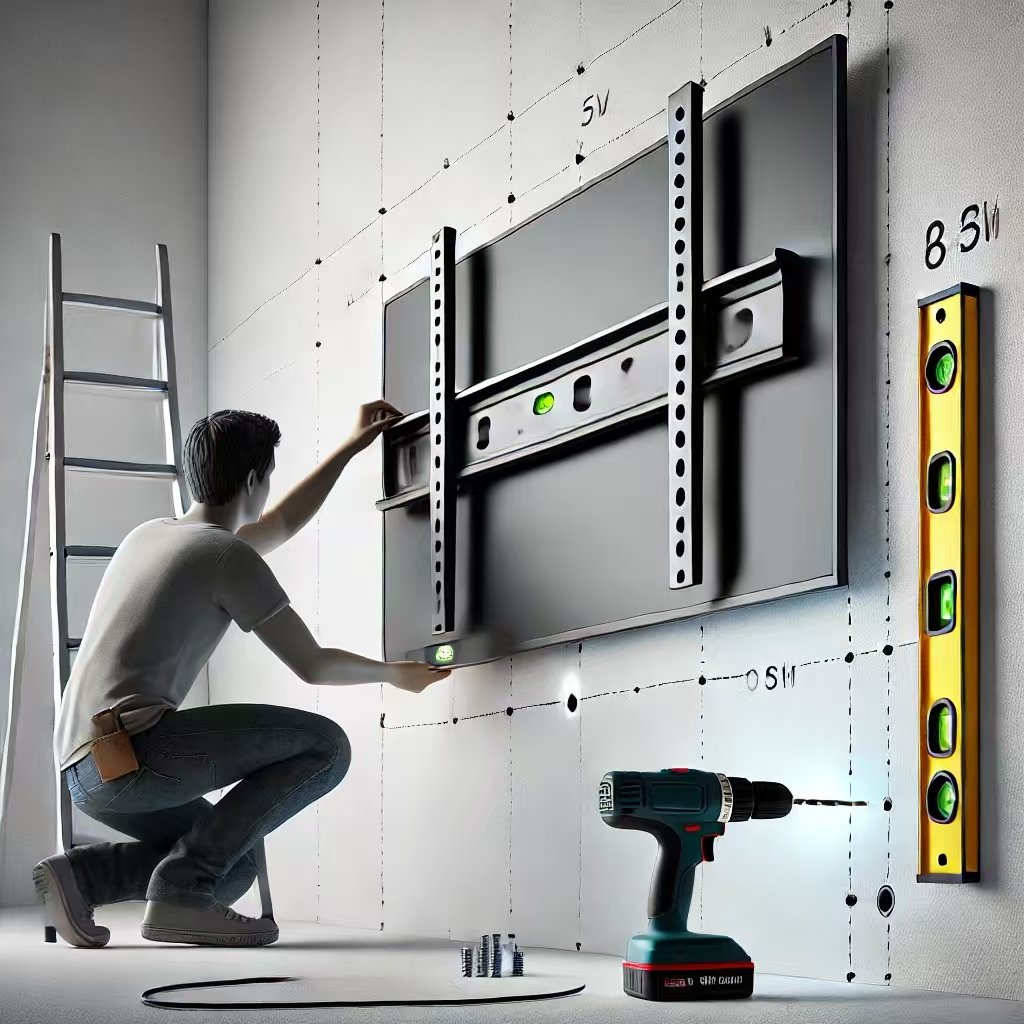
Precision and Patience: Aligning the Bracket
Installing the mounting bracket is a crucial step in setting up multiple LCD monitors on the wall. This step requires precision and patience. A secure bracket ensures your monitors stay in place. It prevents any risks of them falling or becoming unstable. Begin by aligning the bracket with the marked spots on your wall. The alignment of the bracket is important for ensuring that your monitors sit straight and level once mounted.
Marking the Wall for Accurate Placement
First, use a pencil to mark where the screws will go. Make sure these marks align with the studs you found earlier. Drilling into studs provides the best support for your mounting bracket. Without using the studs, the bracket may not hold well, especially if the monitors are heavy. The marks act as a guide for drilling holes. It is better to double-check the alignment before drilling to avoid mistakes.
Drilling Holes Straight and Steady
Next, take out your drill. Using a drill bit that matches the size of the screws, create holes in the wall where you marked. It is important to drill straight and steady. This ensures that the screws will go in smoothly. Drilling at an angle can cause the screws to loosen over time. It might also damage the wall, leading to a less stable mounting setup. After drilling, clear any dust or debris from the holes.
Positioning the Bracket for Level Installation
After preparing the holes, position the bracket against the wall. Make sure it lines up with the holes you drilled. Use a level to check that the bracket is straight. If the bracket is crooked, your monitors will not sit properly. An unlevel bracket can cause an uneven viewing experience. If necessary, adjust the bracket slightly until it is perfectly level. This step ensures your monitors will be evenly aligned once mounted.
Securing the Bracket Step-by-Step
Now, take your screws and begin securing the bracket to the wall. Start by inserting screws into the top holes first. Tighten them using a screwdriver or a drill with a screwdriver attachment. Then, move to the bottom holes and insert the remaining screws. Tightening the screws in this order helps to keep the bracket stable while you secure it. This method prevents the bracket from shifting out of alignment during installation.
Ensuring Secure and Stable Screws
Once all the screws are in place, ensure they are tight. A loose screw can cause the bracket to become unstable. Use a manual screwdriver for the final tightening if needed. It gives you more control compared to a power drill. Avoid over-tightening the screws, as it can strip the threads. This can weaken the hold of the screws in the wall. Tight but not excessively tight is the key here.
Testing the Bracket for Stability
After securing the bracket, give it a gentle shake. This test checks if the bracket is firmly attached to the wall. If it feels loose, check each screw again. Tighten any that might not be fully secure. A properly installed bracket should not wobble or shift when you apply light pressure. This stability is essential for supporting the weight of your LCD monitors.
Verifying Weight Capacity for Safety
At this stage, it’s also wise to double-check the weight capacity of your bracket. Compare it with the combined weight of your monitors. It is better to do this now than to face issues later. Some brackets can handle more weight than others. Ensuring your bracket can handle the load keeps your setup safe and durable. This small step can save you from potential accidents.
Adding Anchors for Extra Support
Additionally, consider adding anchors if your wall does not have studs or if your bracket requires additional support. Anchors provide extra stability. They prevent screws from pulling out of the wall. Plastic anchors work for lighter setups, while metal ones are better for heavier installations. Anchors can be especially helpful when dealing with drywall. They help distribute the weight evenly.
Installing Anchors for Long-Term Security
If you decide to use anchors, drill holes slightly larger than the anchor size. Insert the anchors before placing the bracket. Then, insert screws through the bracket into the anchors. This method ensures a tight and secure hold. It prevents the bracket from loosening over time. Anchors make sure your setup stays in place even with daily use and adjustments.
In conclusion, installing the mounting bracket is a detailed process. It requires attention to alignment, drilling, and securing the screws. Taking the time to do it correctly ensures your monitors remain stable on the wall. With a properly installed bracket, you can confidently move on to the next steps of attaching and adjusting your LCD monitors. A solid foundation makes the rest of the process smoother and safer.
Step 5: Attach the Mounting Plate to the LCD Monitors
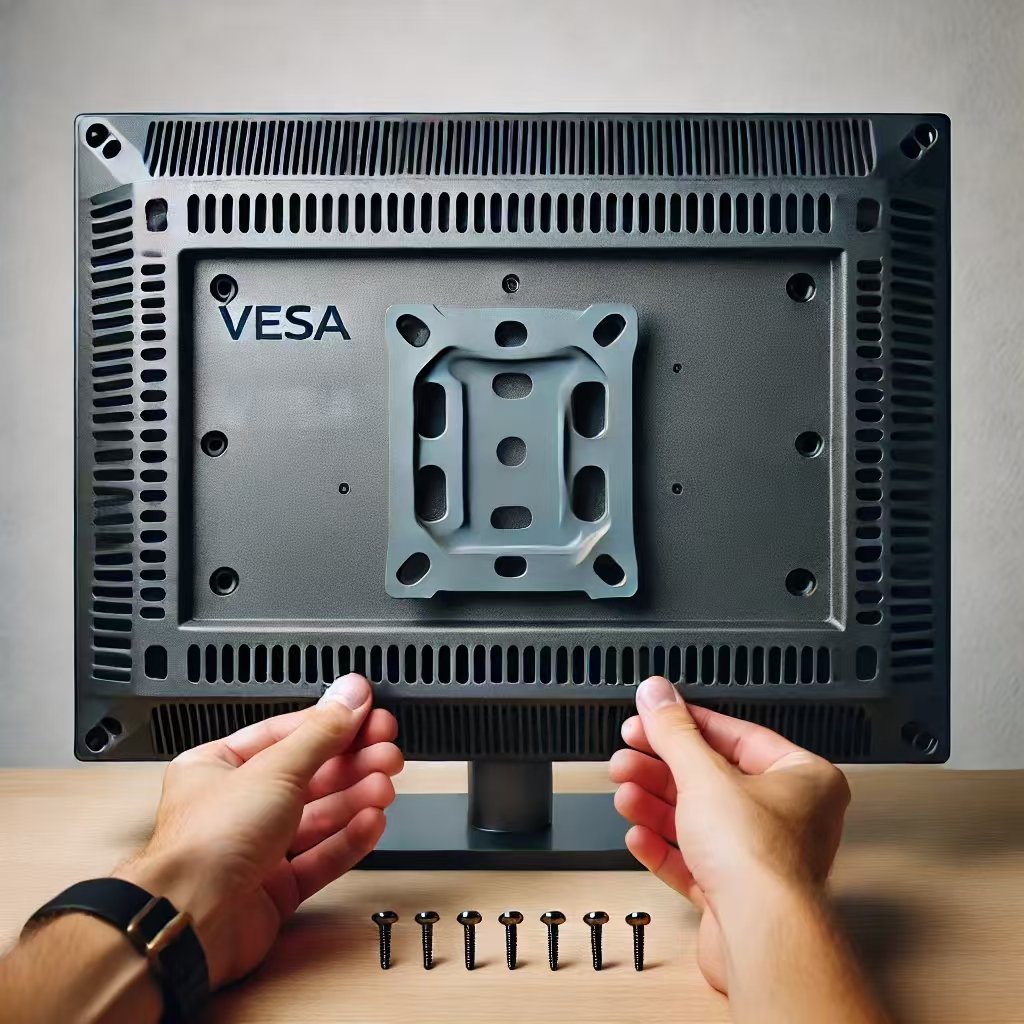
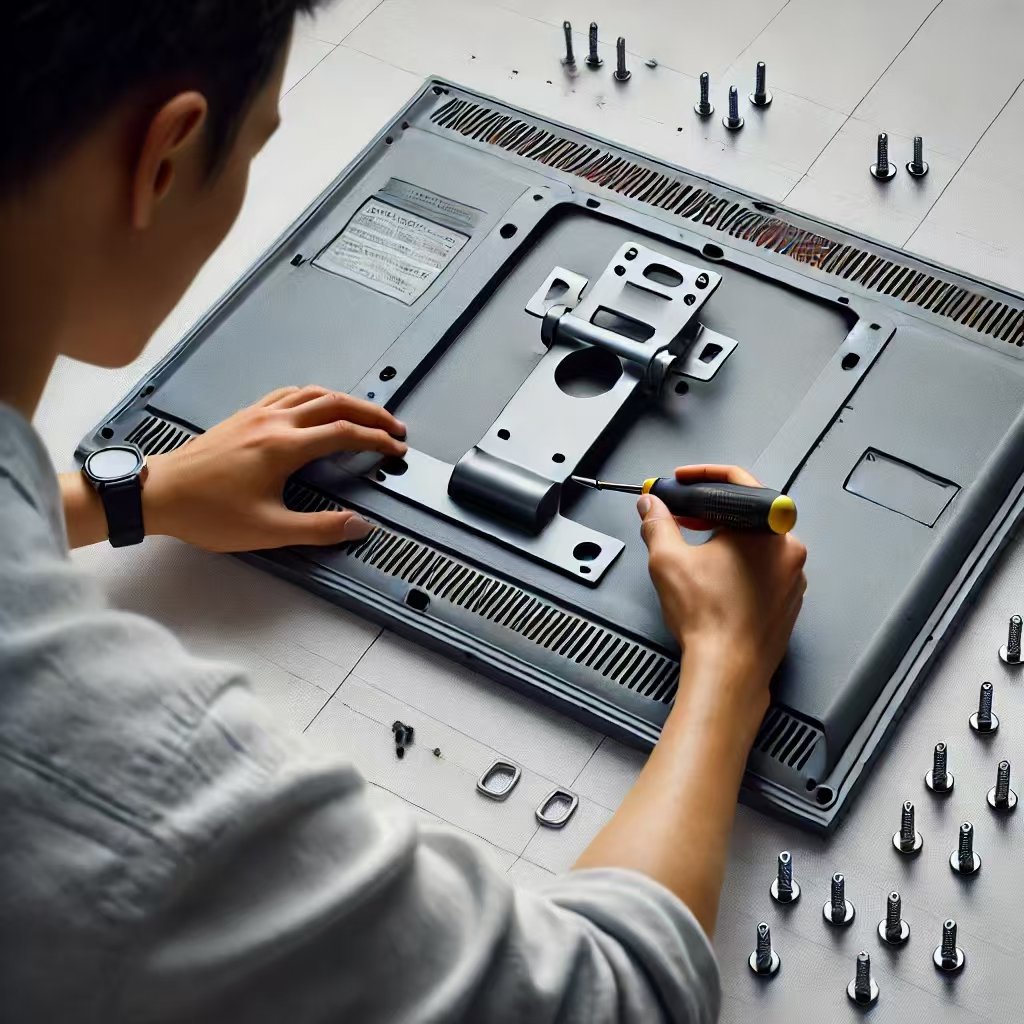
Ensuring Monitor Stability with Correct Mounting Plates
Attaching the mounting plate to each LCD monitor is crucial. This step ensures the stability of the entire setup. The process is simple but requires attention to detail. First, verify the VESA pattern on the back of your monitors. VESA patterns refer to the distance between the mounting holes on the back of your monitor. Most LCD monitors come with standard VESA patterns. They usually range from 75×75 mm to 200×200 mm. Matching the plate with this pattern is essential. If the patterns don’t align, you may need an adapter. Using the correct plate ensures a secure connection between the monitor and the wall mount.
Gathering and Using the Right Screws
After matching the VESA pattern, gather the necessary screws. These usually come with the mounting plate. However, double-check that you have the correct size and type. Using the wrong screws can damage your monitor. It could even weaken the mounting, causing future issues. Once you have the right screws, align the mounting plate with the holes on the monitor’s back. Holding the plate in place with one hand, start inserting the screws with the other.
Tightening Screws Evenly for Balance
Next, tighten the screws using a screwdriver. It’s important to keep the plate steady during this step. The screws should be tightened evenly to ensure the plate sits flat against the monitor. Begin by loosely attaching each screw. Then, once all screws are in place, tighten them gradually in a cross pattern. This method helps distribute the pressure evenly. As a result, it prevents the plate from tilting or becoming unbalanced. Avoid over-tightening the screws, as this could damage the monitor’s casing. Tightening just enough to secure the plate is sufficient.
Verifying Plate Stability Before Proceeding
Transitioning to the next step, it is time to check the stability of the mounting plate. Give the plate a gentle tug to ensure it is firmly attached. It should not wobble or shift when you apply pressure. If you notice any movement, check the screws again. A secure mounting plate provides a reliable connection to the wall mount. This reduces the risk of accidents, such as the monitor detaching from the mount. Safety is essential in this process, especially when handling expensive equipment like LCD monitors.
Repeating the Process for Additional Monitors
After securing the plate, repeat the process for any additional monitors. Ensure each monitor follows the same procedure. Consistency in this step guarantees that all monitors have equal stability. This is especially important when mounting multiple monitors. If one monitor is less secure than the others, it can cause alignment issues. Consistent mounting creates a more uniform and professional appearance. Take your time with each monitor, ensuring that all plates are securely attached.
Enhancing Durability with Washers
Moreover, consider using washers if you notice any gaps between the mounting plate and the monitor. Washers can help create a tighter fit. They prevent the screws from loosening over time. This extra step might seem small, but it adds durability to your setup. It’s a simple precaution that can extend the lifespan of your wall-mounted monitors. Remember, a little extra effort now can save you from adjustments later.
Addressing Potential Fitting Issues
Now, let’s discuss some potential challenges. Sometimes, the mounting plate may not fit perfectly due to variations in monitor designs. In such cases, consider using a universal mounting plate. These plates are designed to fit a wider range of VESA patterns. They provide a flexible solution for non-standard monitors. If you encounter difficulties, consult the mounting plate’s instruction manual. The manual often includes tips for addressing common issues. Taking the time to solve these problems ensures a smoother installation process.
Final Inspection for Flush Fit
Transitioning to final checks, inspect the back of the monitor. Make sure there are no gaps between the plate and the monitor. A flush fit ensures the monitor will hang evenly on the wall. An uneven mounting plate can cause the monitor to tilt when mounted. This would affect the overall alignment of the monitors. It’s better to address these issues before hanging the monitors on the wall.
Finally, ensure you have a clean workspace before proceeding. Remove any loose screws or tools from the area. A clutter-free workspace reduces the chance of accidents. This also helps you focus better on the next steps of the installation. By taking these precautions, you ensure a smooth transition to hanging the monitors. Now, you are ready to move on and attach your monitors to the wall.
Step 6: Hang the Monitors on the Wall
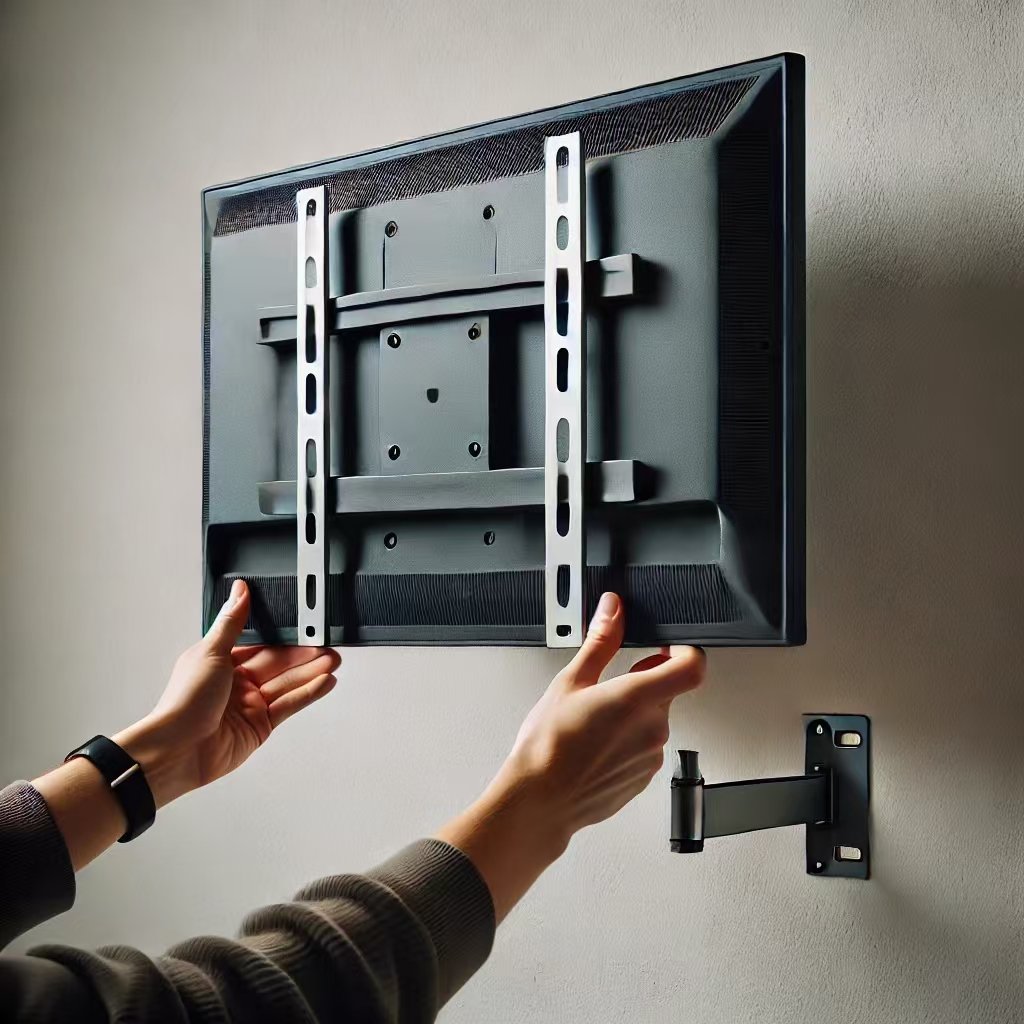

After attaching the mounting plate, it is time to hang the monitors on the wall. This step is crucial for a secure and stable setup. You should lift the monitor with care to avoid any damage. Position the monitor close to the mounting bracket. Then, align the mounting plate with the bracket on the wall. Make sure it fits properly before releasing your grip. This ensures the monitor is firmly attached to the bracket.
Secure Each Monitor Carefully
When hanging multiple LCD monitors, ensure each one is secure. After positioning the first monitor, gently test if it is stable. Give it a light push to see if it moves or tilts. If it feels loose, double-check the attachment. Tighten the screws on the mounting plate if needed. This step prevents accidental falls or shifting. By securing each monitor correctly, you protect your investment and maintain a safe workspace.
Adjust the Position for Alignment
Once you have hung the monitors, it’s important to align them. Proper alignment ensures a seamless viewing experience. To begin, step back and observe the monitors from a distance. Check if they are at the same height. Use a level to verify the alignment. Adjust each monitor slightly until they form a straight line. This process may take some time, but it’s worth the effort. A well-aligned setup enhances the overall look and feel of your workspace.
Fine-Tune the Viewing Angle
Adjusting the viewing angle is another important step. Depending on the type of wall mount, you may be able to tilt or swivel the monitors. A slight tilt can reduce glare and improve visibility. For a multi-monitor setup, adjust each monitor to face toward your main sitting position. This creates a wrap-around effect, which is ideal for productivity or gaming. Adjusting the angle enhances comfort and reduces strain on your neck and eyes.
Test the Stability of Each Monitor
After adjusting the angles, it’s time to test the stability of each monitor again. This step is crucial, especially if you plan to use the monitors daily. Apply gentle pressure to the corners of each monitor. Ensure they remain firmly attached to the wall. If any monitor wobbles, remove it from the bracket. Recheck the screws on both the plate and the bracket. Tightening them can solve most stability issues. A stable setup means peace of mind while using your monitors.
Ensure Proper Weight Distribution
When you mount multiple LCD monitors, pay attention to weight distribution. The wall bracket should evenly support the weight of each monitor. This prevents uneven strain on the bracket, which could cause damage over time. To distribute the weight properly, mount the monitors as close as possible to the wall bracket’s center. This keeps the load balanced and ensures that no part of the bracket carries excessive weight. Proper weight distribution extends the lifespan of your mounting system.
Double-Check the Wall for Stability
After hanging and aligning the monitors, check the stability of the wall itself. Some walls, especially older ones, may weaken under the weight of multiple monitors. Inspect the wall around the mounting bracket. Look for signs of cracks or loose drywall. If you notice any issues, consider reinforcing the wall. Using a plywood backboard can provide additional support. This step ensures long-term stability and safety for your mounted monitors.
Arrange Cables After Mounting
Once the monitors are securely in place, focus on cable management. Hanging the monitors makes it easier to arrange cables neatly. Use zip ties or cable clips to gather the cables together. Route them along the back of the monitors, keeping them out of sight. A well-managed cable setup looks cleaner and prevents tripping hazards. Proper cable management also makes it easier to adjust or replace monitors in the future.
Final Adjustments for the Ideal Setup
With all monitors hung and secured, you can make final adjustments. Fine-tune the height, angle, and spacing between monitors. Test the setup by sitting at your desk and checking the comfort level. Adjust until you are satisfied with the view and reach. This step ensures you can work or game comfortably for long periods. A well-adjusted setup makes a huge difference in your daily experience.
Enjoy a Clean and Professional Setup
Now, you have successfully hung your LCD monitors on the wall. Step back and admire the clean, professional look. A wall-mounted setup transforms any workspace, offering more desk space and a modern appearance. It’s not just about aesthetics; it’s also about creating a functional environment. With the monitors properly mounted, you can focus on your work or enjoy entertainment without distractions. A neat setup enhances productivity and overall satisfaction with your workspace.
By following these detailed steps, you will know how to mount multiple LCD monitors on the wall confidently. It’s a rewarding process that results in a tidy and efficient workspace. Enjoy the benefits of a more organized, stylish, and user-friendly setup.
Step 7: Manage the Cables

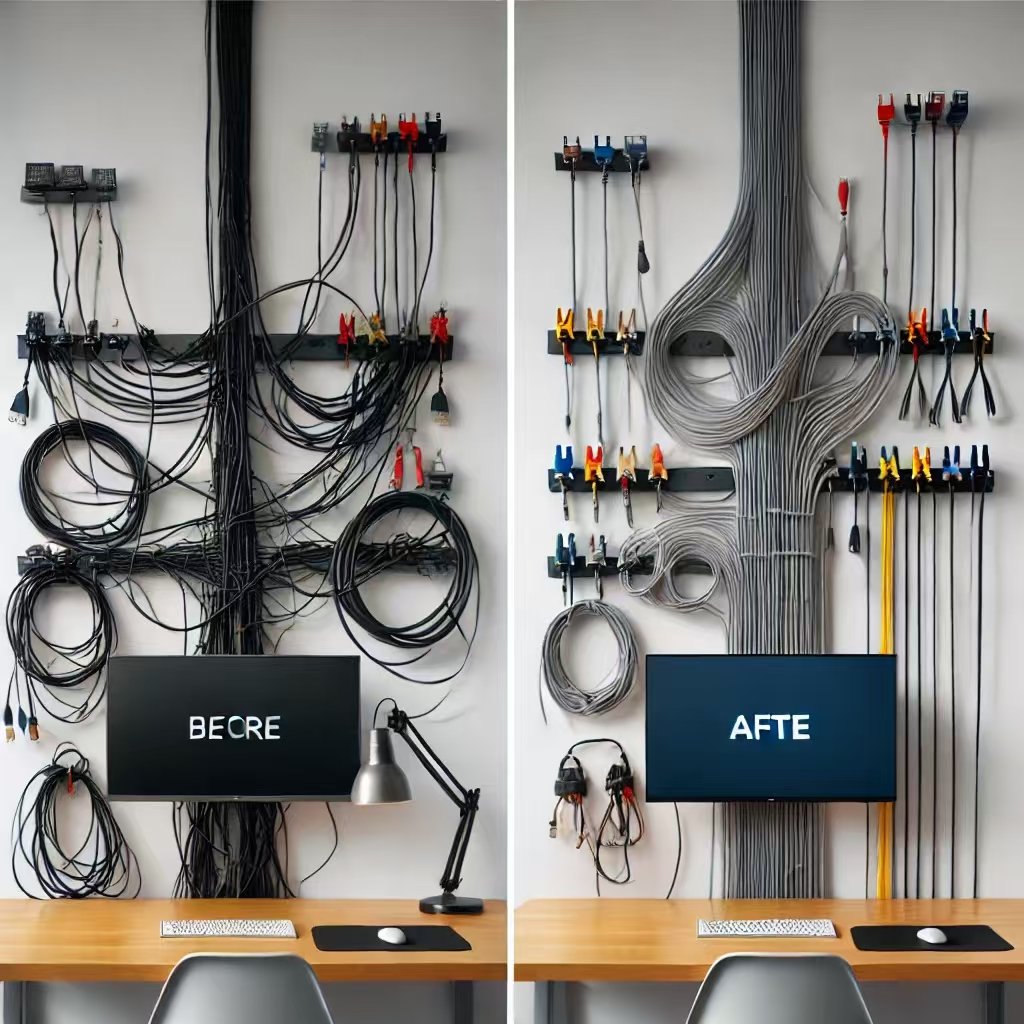
Proper cable management is crucial when you mount multiple LCD monitors on the wall. Without organization, cables can become tangled, creating a messy appearance. Additionally, loose cables can be a safety hazard, especially in a busy workspace. With good cable management, you can keep your space clean and functional. Here’s how to manage cables effectively.
Bundle the Cables Together
The first step is to bundle the cables neatly. Use cable ties or Velcro straps for this purpose. These tools help keep the cables compact and organized. Group cables based on their function, such as power cables and data cables. Bundling cables together also makes it easier to identify them later if you need to disconnect or rearrange. Additionally, bundling minimizes the risk of cables pulling or snagging during adjustments.
Route Cables Along the Back of the Monitors
After bundling the cables, route them along the back of each monitor. Many wall mounts include clips or guides for this purpose. If your mount lacks these, adhesive cable clips can be a great alternative. Attach the clips to the back of the monitors or the wall near the mount. This helps keep cables in place. It also prevents them from hanging down loosely, which can be distracting. Keeping cables close to the monitor creates a streamlined look.
Secure Cables Along the Wall
After routing the cables behind the monitors, secure them along the wall. Use cable clips or raceways for a tidy appearance. Cable raceways are plastic or metal channels that conceal the cables. They are ideal if you want a professional look. You can paint them to match the wall color for a seamless appearance. Clips are a simpler option and are easy to install. Place the clips every few inches along the cable’s path. This keeps the cables tightly against the wall.
Hide Cables for a Cleaner Look
Hiding cables is essential for achieving a clean setup. A messy setup can distract you during work. Using cable sleeves is another effective way to conceal cables. Cable sleeves can wrap around multiple cables, making them appear as a single cord. This reduces the cluttered appearance of several individual cables. If your desk or setup is near a wall, you can also hide cables behind furniture. Place the cables along the edge of a desk or bookshelf to keep them out of sight.
Use Cable Management Boxes for Power Strips
Power strips and surge protectors are common in setups with multiple monitors. However, they can create a mess if not managed properly. Use a cable management box to hide power strips. These boxes have openings on each side, allowing cables to exit while keeping the power strip inside. This not only hides the clutter but also protects the power strip from dust. A clean setup reduces the risk of accidental unplugging and keeps your workspace safer.
Label Your Cables for Easy Identification
Labeling your cables can save you time in the future. Use small labels or color-coded tags for this purpose. Label each cable near its end. This helps you identify cables without needing to trace them back to their source. It’s especially useful if you frequently rearrange your setup or add new devices. With labeled cables, you can quickly find and disconnect the right cable when needed. This makes maintenance much easier and faster.
Avoid Over-Bending Cables
When managing cables, avoid bending them too sharply. Over-bending can damage the internal wires, leading to connectivity issues. Use cable clips or loops to guide the cables in a gentle curve. This prevents stress on the wires and extends their lifespan. A damaged cable can affect the performance of your monitors. By taking care of your cables, you ensure a reliable and long-lasting setup.
Check Cable Length Before Installation
Before mounting the monitors, check the length of each cable. Ensure they reach the power outlet or computer without stretching. If a cable is too short, consider using an extension. Straining a cable can damage the connection points, making it more likely to fail. Extra-long cables, on the other hand, can be bundled and secured. It’s better to have a little extra length than not enough. This makes adjustments easier and keeps your setup flexible.
Secure Loose Cables Regularly
Cable management is not a one-time task. Over time, cables can become loose or shift. Make it a habit to check the cables every few months. Tighten any loose ties and adjust the clips if needed. Regular maintenance keeps the setup looking neat and prevents cables from interfering with your work. A little effort in upkeep can make a big difference in maintaining a clean workspace.
Step 8: Test the Monitors

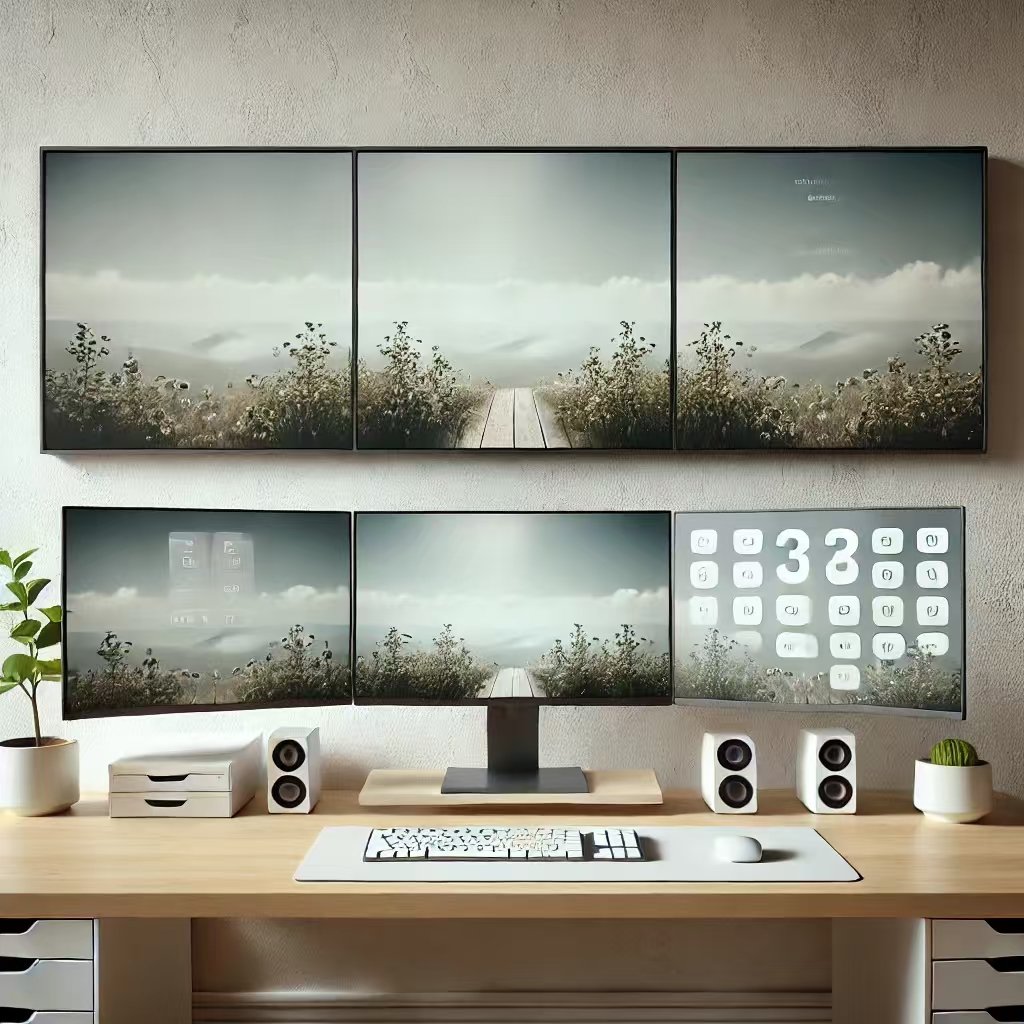
After mounting your LCD monitors, testing them is essential. This step ensures that everything is functioning properly. Start by checking each monitor individually. Connect the power cables to each monitor. Then, plug them into a power source. Turn on each monitor one by one. This helps identify any connection issues early. If a monitor does not power on, recheck the cables. Make sure all connections are secure.
After powering on the monitors, check their alignment. Sit at your usual working position. Adjust the monitors’ angles slightly for better visibility. Ensure that the screens are at a comfortable height and eye level. This prevents neck strain during prolonged use. If a monitor feels off-center, adjust the bracket slightly. Small changes can make a big difference in comfort. Use a level tool to confirm that each monitor is straight.
Adjust Display Settings
After checking the physical setup, focus on display settings. Adjusting the brightness, contrast, and resolution is crucial. This enhances your viewing experience. Go to the display settings menu on your computer. Set the resolution to match each monitor’s capabilities. This prevents blurry images and ensures sharp visuals. Adjust the brightness to a comfortable level. Avoid high brightness, as it may cause eye strain over time.
After adjusting brightness, focus on color calibration. Proper color settings ensure consistency across all monitors. Most operating systems have built-in calibration tools. Follow the on-screen instructions to calibrate colors. This step is particularly important for tasks like graphic design. It ensures that colors look the same across all screens. Testing your monitors thoroughly ensures an optimized setup.
Test Connectivity with Other Devices
Next, test the connectivity of your monitors with other devices. Connect your monitors to external devices like laptops or gaming consoles. This ensures the versatility of your setup. For example, if you plan to use one monitor for work and another for gaming, this test helps. Make sure the HDMI or DisplayPort connections are working properly. Test switching between different input sources. It should be smooth and without delays.
If you encounter any connectivity issues, troubleshoot them. Check if the cables are firmly plugged in. Sometimes, a loose connection causes a black screen. Use a different cable to see if the problem persists. If the issue remains, consult the monitor’s manual. Many common problems have simple solutions. Testing all possible connections gives you confidence in your setup.
Check for Visual and Audio Quality
After testing the connectivity, focus on the quality of visuals and audio. Play a video on each monitor. Watch for any flickering or distorted images. These could indicate a problem with the cables or the monitor itself. Make sure the video plays smoothly. If you notice any visual problems, adjust the refresh rate. A higher refresh rate reduces flickering and provides a better experience.
Check the audio output if your monitors have built-in speakers. Play audio to see if the sound is clear. Adjust the volume to ensure there is no distortion. If the sound is unclear, try a different audio cable. Testing audio is crucial if you plan to use the monitors for multimedia purposes. Good audio enhances the overall experience.
Test for Long-term Stability
It is also important to test the long-term stability of your mounted monitors. Leave the monitors on for a few hours. This test checks if the mount can hold the weight over time. Monitor the wall mount for any signs of strain or loosening. If the mount starts to shift, tighten the screws. This prevents potential accidents in the future.
Observe the temperature of each monitor during the long-term test. Excessive heat can damage the internal components. Make sure the monitors have enough ventilation. Avoid placing them too close to each other. Proper airflow ensures that your monitors run efficiently. Testing for stability ensures that your setup remains secure over time.
Adjust Position Based on Feedback
Finally, make any necessary adjustments based on your testing. Ask yourself if the setup feels comfortable. Adjust the monitors’ positions for better ergonomics. For example, if you feel strain in your neck or eyes, change the height. Small adjustments can greatly improve your comfort. Revisit the display settings if needed. The monitors must meet your personal needs.
Gather feedback from others if you share the space. For example, if you use the setup for presentations, ensure others have a clear view. Adjust the angles for a wider viewing area. This helps make the setup more versatile. After testing and adjusting, you should have a perfect setup. Testing your monitors ensures they perform well under different conditions.
Final Thoughts on Testing
Testing the monitors thoroughly is a crucial step. It ensures that everything works perfectly after mounting. By following these steps, you can enjoy a seamless and comfortable experience. Testing takes time, but it is worth the effort. A well-tested setup prevents future problems. It allows you to focus on your work without interruptions. With a properly mounted and tested setup, your workspace will feel complete and efficient.
Step 9: Enjoy Your New Setup
Enjoying a Sleek and Organized Workspace
Now that your monitors are mounted, it’s time to enjoy the benefits. A wall-mounted setup can completely change your workspace. It offers a sleek and modern look. More importantly, it saves precious desk space. This extra space can now be used for other essentials like documents, a keyboard, or even some decorative items. As a result, you create a more organized environment that allows you to focus better.
Improving Ergonomics and Posture
Moreover, the ergonomic benefits are significant. With your monitors mounted at the right height, you can reduce neck and eye strain. Adjusting them to eye level helps maintain a healthy posture. This is especially important if you spend long hours working on your computer. Many people overlook the impact of monitor height on posture. Yet, it can make a big difference in comfort and productivity. By having your monitors mounted properly, you avoid these common issues.
Customizing Your Viewing Experience
Additionally, the flexibility offered by a wall-mounted setup is noteworthy. Depending on your mount type, you can tilt or rotate your monitors easily. This makes sharing your screen during meetings much easier. If you’re working with multiple applications, you can adjust each monitor’s angle for the best view. It’s a practical solution for those managing multiple tasks at once. The ability to customize your monitor arrangement helps you create a dynamic workspace that adapts to your needs.
Enhancing Professional Appearance
Transitioning to a wall-mounted setup can also make your space feel more professional. Imagine inviting clients or colleagues into your office. A tidy, wall-mounted display can leave a great impression. It shows that you value a well-organized environment. This can even reflect positively on your business image. Whether you work from a home office or a professional setting, appearance matters. A clean setup speaks volumes about your attention to detail.
Achieving a Minimalist Look
Furthermore, a wall-mounted monitor setup is perfect for creating a minimalist look. Cables can be neatly hidden away, which contributes to a clutter-free workspace. Using cable clips or conduits, you can guide the cables along the wall. This simple step can make a huge difference in the overall appearance. A minimalistic approach not only looks good but also reduces distractions. Without messy cables, you can focus better on your tasks.
Maximizing Desk Space for Practical Use
Beyond the aesthetic benefits, the increased desk space provides practical advantages. For example, artists and designers can use the extra space for drawing tablets. Gamers can enjoy an improved setup with more room for peripherals. Even if you just need a space for writing notes or sipping coffee, you will appreciate the added room. The options are limitless when you don’t have bulky monitor stands in the way. This freedom lets you personalize your workspace as you see fit.
Customizing for Enhanced Productivity
A wall-mounted setup also enhances productivity. You can organize your monitors in a way that fits your workflow. For instance, place one monitor vertically for reading long documents. Position another horizontally for video editing or multitasking. This customization allows you to create a setup tailored to your specific needs. It enables a smoother workflow, helping you get more done in less time. The right setup can make a noticeable difference in how you manage your daily tasks.
Reducing Risks and Simplifying Maintenance
Of course, comfort and convenience are not the only reasons to choose a wall-mounted display. There are also long-term benefits. Mounted monitors are less likely to be accidentally knocked over. This reduces the risk of damage to your screens. It also makes cleaning easier since you have more open space on your desk. A safer and cleaner setup contributes to a more pleasant work environment.
Scalability for Future Needs
In addition, think about the versatility of your new setup. You can easily change the arrangement as your needs evolve. If you add more monitors or switch to different models, you only need to adjust the mounts. Unlike desk mounts, wall mounts don’t take up space. This makes them a great option for those who want a scalable setup. It ensures that your workspace can grow with your needs without sacrificing space or style.
Boosting Creativity and Focus
Lastly, a wall-mounted monitor setup can boost your creativity. With a clear desk and a tidy space, your mind can focus better. You might find it easier to come up with new ideas. A clean environment can foster a more positive and creative mindset. It’s a simple change that can lead to better work and a more enjoyable workspace.
In conclusion, knowing how to mount multiple LCD monitors on the wall opens up many possibilities. It’s not just about saving space. It’s about creating a comfortable, efficient, and inspiring work environment. Enjoy your new setup, and take pride in the effort you put into making your workspace better. You’ve made a smart choice that will pay off in many ways. Embrace the change, and let your new setup work for you.
Common Mistakes to Avoid
Expanding on the common mistakes when mounting multiple LCD monitors on the wall will help you avoid issues and ensure a smoother process. Here are key mistakes to watch out for and tips to avoid them.
Mistake 1: Ignoring the Weight Capacity
Many people overlook the weight capacity of the wall mount. This is a critical mistake. A wall mount has a specified weight limit. Exceeding this can result in a dangerous situation. The mount could detach from the wall, causing your monitors to fall. This could lead to damage or injury. To avoid this, always check the weight of each monitor. Add the weights together if you plan to mount multiple screens. Compare the total weight to the mount’s capacity. Choose a mount that supports more than the combined weight of your monitors. This adds a safety margin.
Mistake 2: Not Using a Stud Finder
Another common error is skipping the use of a stud finder. Mounting directly into drywall can be risky. Drywall alone may not support the weight of multiple monitors. Using a stud finder helps you locate studs behind the wall. Mounting into studs ensures the setup is secure. It provides a stronger hold, especially for heavier setups. To avoid this mistake, invest in a good stud finder. They are easy to use and relatively inexpensive. Mark the stud locations clearly before drilling. This ensures a more stable installation.
Mistake 3: Misaligning the Mount
Misalignment of the mount is a frequent mistake. Even slight misalignment can result in uneven monitors. This can disrupt your viewing experience. It may even cause strain if you have to adjust your posture constantly. To avoid this, use a level during the installation process. Check the alignment of the bracket before tightening the screws. Adjust the position until it is perfectly level. Take your time during this step. Ensuring proper alignment makes a big difference in the final result.
Mistake 4: Over-Tightening Screws
Over-tightening screws can damage both the wall and the mounting plate. It may seem like a good idea to secure the screws tightly. However, too much force can strip the screws or crack the wall. It could also damage the mounting holes on the monitor. To avoid this mistake, tighten screws until they are snug. Stop when you feel resistance. A secure but not overly tight fit is sufficient. If you are unsure, use a torque screwdriver. This tool helps apply the correct amount of pressure.
Mistake 5: Skipping Cable Management
Proper cable management is often neglected. This can result in a messy and disorganized setup. Tangled cables can pull on the monitors, potentially affecting their alignment. They can also make it difficult to clean around the setup. To avoid this mistake, plan your cable management before mounting. Use cable ties, clips, or a cable raceway to keep cables organized. Bundle cables neatly and secure them along the back of the monitors. This keeps them out of sight and prevents tangling.
Mistake 6: Choosing the Wrong Wall Type
Some walls are not suitable for mounting heavy equipment. Drywall without studs is an example. It is not strong enough to hold multiple monitors. Concrete walls are better, but they require special anchors. Choosing the wrong wall type can lead to an unstable setup. To avoid this, evaluate your wall before starting. If you have drywall, locate the studs and use them for mounting. If you have a concrete wall, buy the right anchors. This will ensure a safe and stable setup.
Mistake 7: Rushing the Installation
Rushing through the installation process can cause mistakes. It is easy to miss a step or improperly secure a part. This could compromise the stability of your setup. To avoid this, take your time. Follow each step of the installation guide carefully. Double-check your work as you go. Rushing can lead to more time spent fixing errors later. A careful and steady approach will lead to a better result.
Mistake 8: Failing to Adjust Viewing Angles
Once the monitors are mounted, many people forget to adjust the angles. Proper adjustment can improve your viewing comfort. A bad angle may cause neck or eye strain. To avoid this, adjust the monitors to your preferred height and angle. Test different positions to find the most comfortable setup. Full-motion mounts offer flexibility for adjustments. Make use of this feature if available.
Mistake 9: Using the Wrong Screws
Using screws that are too long or too short can cause problems. Screws that are too long may pierce through the wall. This can damage wiring or pipes behind the wall. Screws that are too short won’t secure the mount properly. To avoid this, use the screws that come with the mounting kit. If you need to replace them, make sure they are the correct size. Always follow the manufacturer’s recommendations for screw size.
By being aware of these common mistakes, you can avoid potential issues. A well-planned installation process ensures a secure and stable setup. Take your time, use the right tools, and follow the guidelines. Doing so will give you a cleaner, safer, and more enjoyable workspace.
Conclusion: Why Learn How to Mount Multiple LCD Monitors on the Wall?
Creating a Clean and Organized Workspace
Mounting multiple LCD monitors on the wall offers many benefits. It creates a clean and organized workspace. When you clear up desk space, you can use it for other essential items. This makes your work area more efficient. A clutter-free environment helps you stay focused and productive. The simple change of moving monitors to the wall can make a big difference.
Enhancing Comfort and Reducing Strain
Additionally, wall-mounted monitors provide flexibility. You can adjust the height and angle of each screen. This makes it easier to find the most comfortable viewing position. Adjusting your screens reduces strain on your neck and eyes. For those who spend long hours at their desks, this is crucial. It leads to better posture and a healthier work routine. This can greatly improve your overall work experience.
Elevating Your Professional Image
Moreover, a wall-mounted setup looks more professional. If you have clients visiting your workspace, a neat and organized area makes a good impression. It shows that you care about your work environment. It can also enhance the image of your business. In competitive industries, every detail matters. A professional setup can make your space stand out.
Maximizing Investment Through Smart Setup
Transitioning to a wall-mounted setup is a smart investment. The initial time and effort pay off in the long run. It can prevent wear and tear on your monitors. By reducing desk clutter, you also extend the life of other equipment. This can save you money over time. It is a practical solution for those looking to maximize their investment in technology.
Empowering Yourself with Practical Skills
Lastly, learning how to mount multiple LCD monitors on the wall empowers you. You gain a valuable skill that can be used in various settings. Whether you are setting up a home office or upgrading a commercial space, this knowledge is useful. You can even help others with their setups, adding value beyond your own workspace. It’s a small step that can lead to a big impact on your productivity and satisfaction.
In conclusion, mounting multiple LCD monitors on the wall is more than just a technical task. It’s about creating a space that works for you. It enhances your comfort, boosts your productivity, and leaves a positive impression. By following this guide, you can achieve a seamless and stylish setup. Embrace the change, and enjoy the benefits of a well-organized, wall-mounted workspace.
